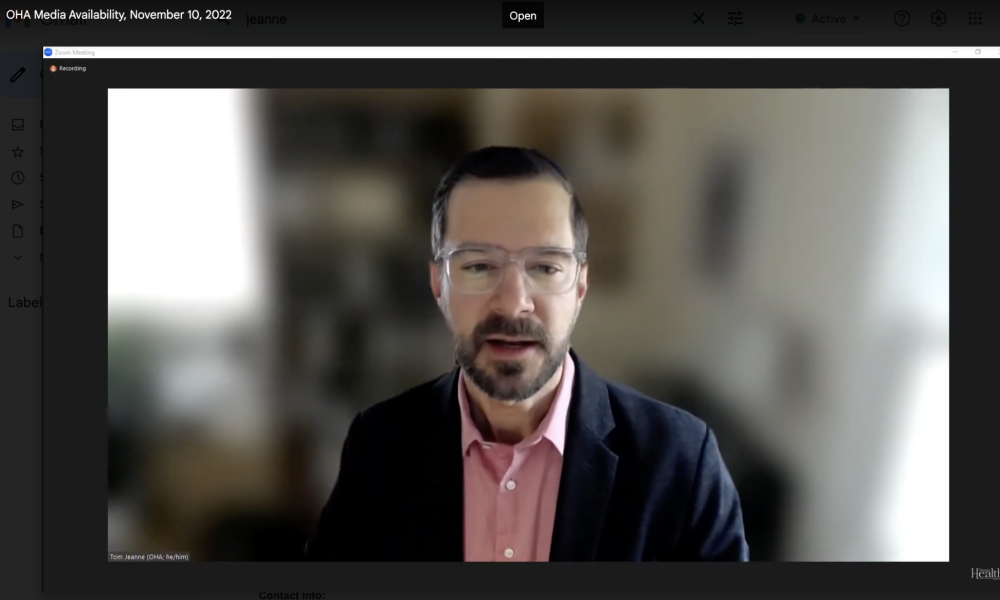Oregon public health officials are keeping an eye on a trifecta of illnesses as winter approaches and Oregonians spend more time indoors: Covid-19, a respiratory virus that’s affecting children and influenza.
This will not be a respiratory illness season like the last two, when the focus was on Covid-19, a virus that primarily affects adults. This year, Oregon health officials are also concerned that a rise in a respiratory virus known as RSV that affects children and infants could squeeze the state’s pediatric bed capacity. And with the pandemic-era lockdowns and mask mandates no longer in force, the state could see more influenza cases.
The Oregon Health Authority is recommending Oregonians to take the precautionary measures they can to preserve hospital capacity. Those steps include staying up to date on Covid-19 vaccines and booster shots, getting a flu shot and taking hygiene-related precautions like hand-washing, covering coughs and sneezes, Dr. Tom Jeanne, the authority’s deputy health officer and deputy state epidemiologist, said in a Thursday press briefing.
“We don’t expect this winter’s Covid wave will be as extreme as last year’s Omicron wave,” Jeanne said, stressing that other illnesses like influenza and a respiratory virus also factor into the picture.
A latest forecast by the Oregon Health & Science University predicts that Covid-19-related hospitalizations in Oregon could peak at about 280 by early December, Jeanne said. There are currently 229 people with Covid in Oregon hospitals.
Oregon also is seeing more respiratory syncytial virus cases, also called RSV. The virus causes lower respiratory infections primarily among infants and children, Jeanne said. Symptoms can include a fever, runny nose, coughs and sneezing. Others at risk include adults 65 and older and those with weakened immune systems.
There were 227 positive RSV tests in Oregon and southwest Washington the week of Oct. 30 to Nov. 5, health authority data show. That’s up from 29 in the first week of October.
As a result, health officials are carefully monitoring infections – and pediatric bed capacity.
“Pediatric capacity is currently limited in Oregon and is expected to be heavily strained based on forecasted levels of RSV activity,” Jeanne said.
Statewide, Oregon has about 534 pediatric hospital beds for children, state data shows. As of Thursday, the state had 36 available beds in neonatal intensive care units, 34 for pediatric non-intensive care and only four available pediatric intensive care beds.
In a Wednesday advisory to hospitals, the health authority urged hospitals to prepare for more demand by identifying staff with pediatric experience who could work in pediatric units, turning single rooms into double rooms and potentially limiting elective procedures if necessary to maintain enough statewide pediatric bed capacity.
“We need to work together and protect hospital capacity so all of us have access to critical care when we need it,” Jeanne said.
In a statement, Becky Hultberg, president and CEO of the Oregon Association of Hospitals and Health Systems, said hospitals are getting ready for a surge of pediatric patients.
“Meeting the needs of all patients is the number one priority of Oregon’s community hospitals and clinics despite the current and anticipated spike in hospitalizations,” Hultberg said. “Our hospitals stand ready to care for everyone in need, and we plan for an increase in respiratory illness each year as we approach the fall and winter seasons. While there is no vaccine for RSV, we recommend that parents ensure that children are current on recommended vaccines.”
Health officials advised Oregonians to put together a care plan in case they become ill and, if they have mild symptoms, to contact their health care provider first instead of going to a hospital emergency room.
Young children and older adults at risk of contracting RSV should consider wearing a mask indoors, health officials said.
Monkeypox cases drop
Also during the press conference, Jeanne said monkeypox cases have sharply dropped.
The state has had only 11 cases in the last four weeks, about two or three each week. Oregon had 241 cases as of Tuesday, Jeanne said.
He said the people at risk, mainly men who have sex with men, need to be fully vaccinated.
“By no means are we declaring victory,” he said.
The state has administered more than 10,990 first doses and nearly 5,200 second doses of the Jynneos vaccine, which is the main one used against monkeypox, he said.
As a result, about 5,790 people are eligible to receive the second dose but haven’t gotten it yet.
The first dose of the vaccine kick starts the immune system to fight the virus, but maximum protection comes two weeks after a second dose.
Monkeypox spreads primarily through close skin-to-skin contact, usually during intimate or sexual contact, and causes lesions. It also can spread from an individual through a caregiving relationship, such as from a parent to a child, or from an adult caretaker to another adult.
“We continue to encourage those who received the first dose to get the second dose as soon as possible,” Jeanne said.
Early next week, health authority workers will start to contact people eligible for the second dose, urging them to get the shot.
Those who received one dose are eligible to get a second dose 28 days after the first shot.
Oregon Capital Chronicle is part of States Newsroom, a network of news bureaus supported by grants and a coalition of donors as a 501c(3) public charity. Oregon Capital Chronicle maintains editorial independence. Contact [email protected]. Follow Oregon Capital Chronicle on Facebook and Twitter.




